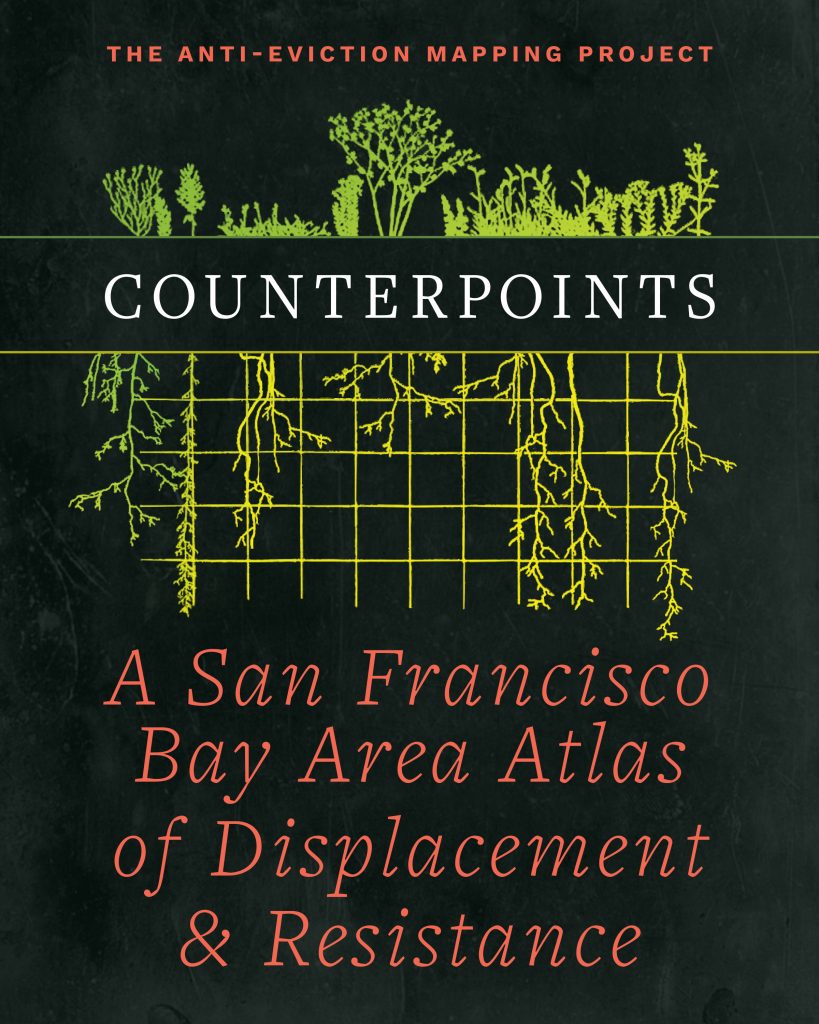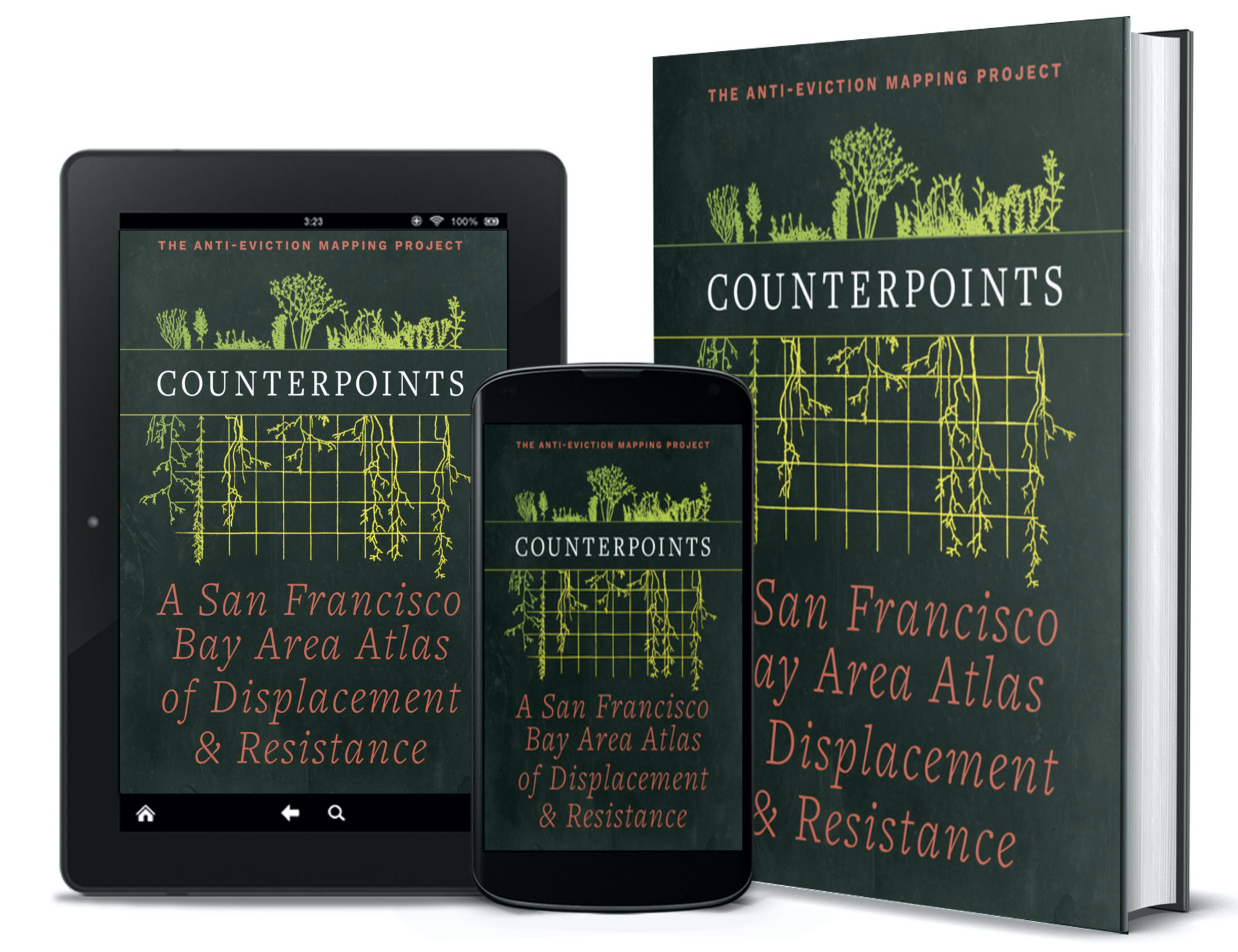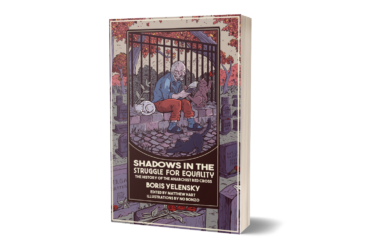By Andrew Szeto, San Francisco
Terra Graziani, CUNY Geography
Erin McElroy, University of Texas at Austin
Radical Housing Journal,
July 2022, Vol 4(1)
Abstract
In this conversation, Andrew Szeto and Terra Graziani share more about their coedited chapter, “Gentrification & State Violence,” one of seven chapters comprising the Anti-Eviction Mapping Project’s 2021 atlas, Counterpoints: A San Francisco Bay Area Atlas of Displacement and Resistance published by PM Press. Here Erin McElroy (also a Counterpoints editor) asks them how they conceptualize the interconnectedness of gentrification and state violence and what Lacino Hamilton has nominated “the gentrification to prison pipeline.” Graziani and Szeto contextualize several contributions in their chapter which explore the criminalization of homelessness, Black culture, and sex work, while also exploring ongoing abolitionist work against the prison industrial complex.EM: Last year, in 2021, the Anti-Eviction Mapping Project (AEMP) published its first atlas project, Counterpoints: A San Francisco Bay Area Atlas of Displacement and Resistance with PM Press. Each of its seven chapters focuses on a theme that the AEMP collective identified as being integral in helping map out the contours of dispossession unfolding across the Bay Area, but also spatial/racial justice organizing and resistance. The two of you coedited one of the atlas’s chapters, “Gentrification and State Violence,” which addresses the entanglement between displacement and carcerality, but also abolitionist housing justice organizing. It weaves together a range of contributions from Bay Area writers, organizers, artists, and cartographers, each of which offers important insight into the BayArea past, present, and future.
Your chapter begins with a story written by Lacino Hamilton on “the gentrification to prison pipeline.” What does this mean, and why is it important to map out gentrification and state violence together?
AS: When we began editing this chapter, prison industrial complex abolition was not yet widespread in housing justice organizing. In the earlier days of this resurgent housing and tenant movement in San Francisco, I can remember many people in the movement questioning this relation as separate issues. They had a hard time conceiving their personal struggles with their landlords relating to police violence. Of course, this had a lot to do with the race and class composition of the tenant movement, which has been active since the 1970s, as well a kind of general post-racial liberalism of progressive politics in the city.
The murder of Alex Nieto by SFPD was a catalyst in many ways in bridging long established PIC abolitionist frameworks and organizing with the housing justice movement. Internally, those of us that were already organizing on both fronts tried to do more political education and to also make connections with existing communities andorganizations doing this work. For example, when I was on staff at the San Francisco Tenants Union, I utilized our position and legitimacy as an organization to do coalitional work with the No New SF Jail Coalition, which successfully stopped a $500 million jail replacement project in 2015. Often in this time, marches and rallies for housing justice and anti-police violence intersected and we shared a lot of direct action infrastructure.
Lacino Hamilton’s conceptualization of “the gentrification-to-prison pipeline” was the perfect way to highlight the foundational interconnection between displacement and policing (2021, 173). While he writes about his own displacement and incarceration in Detroit, we felt that, as did so many others, his framework was especially relevant to the contexts of the Bay Area, where there has been expansion of the PIC through jail expansion in SF or Alameda, the criminalization and sweeps of unhoused communities, and continued policing of Black and Brown neighborhoods. That is, his writing helps make clear that gentrification is state violence.
TG: This chapter is about the co-constitutive nature of police and property – looking at property and its protection as the impetus for police and at the ways these two forces have built on one another over time. The pieces in this chapter show us how these entanglements enact violence in Bay Area neighborhoods—whether it’s via the criminalization of homelessness, racialized police killings, displacement by ICE, the criminalization of sex work, POC-owned nightclub shut-downs, state military contractsSzeto, Graziani & McElroy. (to name a few pieces in the chapter)—we wanted to visualize the broad web of actors involved in upholding and reinstantiating the property-police nexus AND theinterconnected organizing happening to identify and resist this violence.
EM: What are some other contributions to your chapter that help illuminate the relationship between policing, the prison, and housing?
TG: “Policing and Place-Taking in Downtown and Oakland Nightlife” by Alex Werth and the accompanying cartography in the atlas tell the story of the city and police’s role in the whitening of music and nightlife club ownership in downtown Oakland. Tracking the ownership of clubs and dancehalls by race between 2001-2016, he shows us how during this time, Black-owned clubs plummeted from 55% to 35% while white ownership went from 20% to 61%. Alex puts these numbers in context. As this area of Oakland gentrified after decades of state neglect, the city and OPD (Oakland Police Department) began a campaign of “securing” nightlife, which resulted in a racializedpattern of municipal action against clubs. He finds that this more-so than rising commercial rents is the reason for the shift. This of course coincides with the gentrification of Oakland First Fridays, a beloved arts and culture street festival that over time saw more police action and whiter crowds. Alex closes with a powerful point – he writes, “Black popular music continues to move crowds throughout the district. But today at least half of the venues spinning R&B and dance halls are all owned by whites. In 2001, none of them were” (Werth, 2021, 219).
AS: The reflections from the Stop the Injunctions Coalition organizers in Oakland really show the specific spatial elements of these connections. The gang injunctions mapped out a geography where Black and Latinx neighborhoods that faced organized abandonment and heightened policing and surveillance were precisely the same neighborhoods mapped out by real estate speculators for gentrification. North Oakland and Fruitvale are two neighborhoods that have, in recent years, seen an influx of wealthy people purchasing and/or flipping houses. While a map of the actual boundaries of the injunctions did not make the chapter, looking at them in comparison to the infamous NOBE map made by an Oakland realtor, would show this overlap.
Abolitionist organizers involved in the coalition were not necessarily thinking about housing policies when fighting the gang injunctions but used this relationship between housing displacement and policing to build a broad base of opposition to eventually win their campaign. That is to say, they were not distinct issues but were co-constitutive ofeach other. To fight the gang injunctions was to recognize all of the political and economic ways criminalization is used to clear out neighborhoods for new residents.
This kind of coalition work helped pave the way for future abolitionist campaigns in the East Bay like the Stop Urban Shield Coalition, which again brought together both PIC abolition groups and housing rights organizations like Causa Justa Just Cause, to end a militarized police training expo that took place in Alameda County each year.
EM: What does the criminalization of houselessness look like in the Bay Area? What stories in your chapter help illuminate this?
AS: In the last couple of years, but especially with the recent moral panic around the supposed “crime wave”, unhoused communities have been facing increased violence through sweeps and harassment.
TG: The 6-page spread by Paul Boden, Chris Herring, and Jeff Garnand focuses on the criminalization of homelessness in SF, and members of AEMP made maps to go along with the research. One map that stands out shows all existing anti-homeless laws statewide – 592 in total – which outlaw standing, sitting, resting, sleeping, camping, begging, panhandling, and food sharing in CA cities. Fifty-nine percent of these were enacted since 1990. And this number has probably increased with the passing of laws like 41.18 in Los Angeles, which amends the municipal code to place categorical restrictions on where people can sit, lie, and sleep in public – including a 500-foot buffer around schools, parks, and daycares, and a 10-foot restriction around driveways and doorways (AEMP, 2020). This patchwork of rules, aside from enforcing cruel exclusion from public space, is also nearly impossible to navigate and follow. The other maps in this piece show the spatialization of homeless complaints, which happen almost exclusively in gentrifying areas of SF.
I think the San Francisco Jail Population map brings the connections between the prison-industrial complex and gentrification to light in such a clear way. We mapped the zip codes of where people imprisoned reported living before they were arrested and jailed, and we see how the criminalization of homelessness and sex work, and the displacementof Black and Latinx communities are reflected in the city’s jails. Over 20% of those in the jails did not have an address or were unhoused. Keeping in mind that Black residents of SF make up just 3% of the total population, Black people make up more than half of those jailed. The Mission, Fillmore, Tenderloin, and Bayview, where gentrification has brought increased policing, are also the neighborhoods that have the most representation in the city’s jails. This is the result of the ways that racist policing and gentrification work hand in hand to produce surplus populations, even as the city continues to be hailed as a liberal and progressive haven.
EM: What does an abolitionist approach to housing justice look like in the Bay Area and beyond? What groups are actively engaged in this struggle?
TG: Though this happened after we put the atlas together, the Moms for Housing (and coordinated Reclaimers in LA) struggle was transformational in this regard. The Moms for Housing, which came out of ACCE, was a group of unhoused mothers and their children who reclaimed a foreclosed home owned by Wedgewood in West Oakland.They really put this movement—a house should be used as a home, not as a profit engine—at the forefront, and it galvanized so many people to think critically about private property and its utility. So, I bring this up in regards to abolitionist approaches to housing justice, because it showed people through action what can be done with a houseinstead of profit. And to me, that is abolitionist.Szeto, Graziani & McElroy.139 I was involved in the Reclaimers work in LA while I worked at LACCLA (The Los Angeles Center for Community Law and Action). Through property research in coalition with United Caltrans Tenants and ACCE, we found that a whole neighborhood of homesowned by Caltrans had been sitting vacant since the 70s because Caltrans bought the land to develop a section of the 710 freeway, but then never built it. Because enough time had passed, these homes were about to go on the market, but we got together and said “no – there are 60,000 people sleeping on the streets of Los Angeles every night – why couldn’t they live here?” So, that’s when we started planning a campaign to move certain unhoused members and families of our organizing community into these houses. We got furniture, food, bbq grills, everything donated. We had a whole network of people ready to show up at any time to defend the houses, and we trained our people to know what to do in case of arrest. We ended up occupying 13 of these houses, and that campaign continues.
All of these campaigns came out of the same ecosystem where we were finding that, for example, there are three homes that sit vacant every night for every unhoused person on the street in Los Angeles. And that number is four for Oakland. This real estate sits vacant for profit’s sake when it could be a home. Making these connections with the factthat homelessness is so criminalized shows us an even broader prison industrial complex—one that includes housing and the vast web of actors that stand to gain from eviction and displacement. I feel a real groundswell and movement that these connections are being made, but we have more work to do.
AS: I think that borrowing concepts from PIC abolitionists, like non-reformist reforms and critiques of the state, can help push the tenant and housing movement to hold a more radical and principled line. Too often housing justice organizers, especially affordable housing developers, get swept up in various tweaks like affordability percentages in new development or other technocratic fixes that they aren’t engaging in the struggle in a way that is building movements of resistance. They just help manage the crisis. San Francisco’s method of utilizing the ballot initiative as a way to expand tenant protections worked contradictorily over the last 30 years, building a strong progressive tenant voting base but remains too single-issue focused. At the same time, electing progressives into local office can be one way to avoid the constant burnout of ballot initiative campaigning but can lose touch with autonomous grassroots organizing that have more radical critiques of the state and are more multi-issue focused. Instead, the recent call forabolishing rent is one way to think about this abolitionist approach for example. If the horizon of organizing is to move from this point of rent abolition, then the approaches to reach this goal will have us questioning some of the actual reformist reforms presented by electeds or nonprofits. The goal is not simply to win one election here or one ballotinitiative there, but to transform the settler-colonial, capitalist property relation all together.
I would say this abolitionist approach is still emerging, with groups like TANC holding a more radical line around rent abolition. The broad coalitions I mentioned at first between progressive nonprofit “base-building” housing organizations and PIC abolitionists is also something that is growing, both in terms of progressives becoming more abolitionist but also in that PIC abolitionists are beginning to learn more about the radical housing and tenant struggle. I became a member of Critical Resistance in 2015 because I saw that the organizing that I was doing with the SF Tenants Union and Anti- Eviction Mapping Project was becoming more interconnected with the No New SF JailCoalition’s work. The NNSFJ Coalition was able to continue utilizing these relationships and, through a broad effort between many organizations and groups, we won our #ShutDown850 campaign to close the jails at the Hall of Justice in 2020. Lastly, autonomous groups like Gay Shame continue to hold the line against the mainstreaming of the reactionary YIMBY movement, which perhaps is one of the most important struggles right now for the housing justice movement.
References
Anti-Eviction Mapping Project (2020) “Services Not Sweeps.” Available at: https://antievictionmap.com/services-not-sweeps (Accessed 23 May 2022).Anti-Eviction Mapping Project (2021) Counterpoints: A San Francisco Bay Area Atlas of Displacement and Resistance (Oakland: PM Press).Graziani, T. & Szeto, A., eds. (2021) Gentrification & state violence, in: Anti-Eviction Mapping Project, (Ed) Counterpoints: A San Francisco Bay Area Atlas of Displacement and Resistance, pp.173-228 (Oakland: PM Press).Hamilton, L. (2021) The gentrification to prison pipeline, Gentrification & state violence, in: Anti-Eviction Mapping Project, (Ed) Counterpoints: A San Francisco Bay Area Atlas of Displacement and Resistance, pp. 176-180 (Oakland: PM Press).Werth, A. (2021) Policing and place-taking in downtown Oakland nightlife, in: Anti-Eviction Mapping Project, (Ed) Counterpoints: A San Francisco Bay Area Atlas of Displacement and Resistance, pp. 219-222 (Oakland: PM Press)







